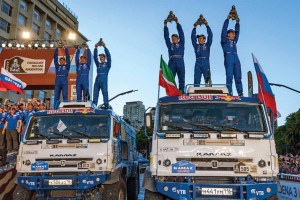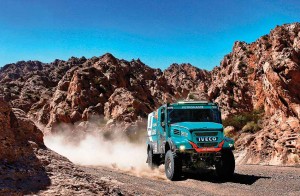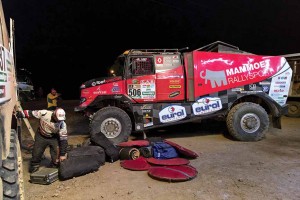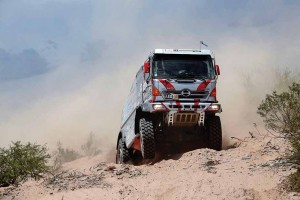Like the earlier edition, the 2017 Dakar Rally proved to be a test of endurance, patience and, experience.
Story by: Team CV
Russia’s Eduard Nikolaev of the Kamaz-Master truck team claimed his second Dakar rally title on January 14, 2017. Nikolaev completed the final stage between Rio Cuarto and Buenos Aires, Argentina, with a 19-minute lead over his nearest rival to repeat his Dakar success of 2013. Second place was taken by another Russian Kamaz-Master driver, Dmitry Sotnikov, who left defending champion Gerard de Rooy of the Netherlands and his Iveco in the third spot. The Russians were a dominant force in the Dakar truck category with Kamaz bringing home 14 titles since 1996.
In what would be a fierce competition, Martin Kolomy of the Czech Republic surprised the trucks field in the opening stage of 2017 Dakar rally with a first place finish in exactly 30 minutes. Martin Van den Brink and Ales Loprais were placed thirty seconds behind the leader, whilst the title holder Gerard de Rooy (piloting an Iveco Dakar truck) managed to limit the damage to 42 seconds with his left rear wheel catching fire in the last kilometre! Winner of the 2016 title, Gerard De Rooy, started first. He started ahead of the Kamaz driven by Airat Mardeev and the Iveco of Federico Villagra. An announcement by Mark Coma, Dakar Sporting Director, before the start of the event, that the route of the 2017 Dakar preserves rally-raid traditions, held true through out the event as the truck teams fought it out. Coma mentioned that the physical challenge will push the competitors into the world of extreme endurance as they cover seven selective sections over 400 kms with one of them stretching to more than 500 kms. “The rally will be held over six days at more than 3,000 m above sea level. The level of difficulty will increase just until the rest day, then a second increase in power will be necessary, to reach one’s ideal level for the ‘Super Belén’. Nothing will be decided until the very last special stage at Río Cuarto,” he added.
After the first stage in Paraguay that comprised of 39 km only, and against the clock, the competitors got down to grinding their teeth in the first big portion of the Dakar 2017 rally. Stage 2 marked the arrival of the rally into Argentina. The rally, made up of bikes, quads, cars, SSVs, and not just trucks, ran over 800 km of treacherous terrain, including a 275 km special in the region of Chaco. In the special, it was patience that counted the most as the participants faced the dust. It was the kind of dust that turned into mud if it rained. The going was not easy by any means. The route leading to San Miguel de Tucuman could allow Peter Versluis, behind the wheel of a MAN truck, to increase his haul of victories if the provisional results at CP1 were to be believed. Already a winner of four stage victories, Peter Versluis was by no means a novice. The route leading to San Miguel de Tucuman could allow him to increase his haul of victories too. The MAN truck driver led Dmitry Sotnikov and Artur Ardavichus after 120 km of the special. Twenty-three seconds ahead of Sotnikov, Peter Versluis continued to lead the stage. Kolomy was placed second, and Martin Van den Brink was placed third – less than 40 seconds behind. The last few kilometres were decisive. Having come fourth in Stage 1, Maritn Van den Brink, driving a Renault truck, moved up several gears after 200 km to lead the scene. He set the pace in Stage 2, building a lead over three-minutes.
Martin Van Den Brink scored a superb victory in Stage 2, soaring over the end of the special to win with a gap of two minutes over Dmitry Sotnikov. It was Dmitry Sotnikov that the Dutchman was previously neck-to-neck. Martin Kolomy, who finished eighth on the day’s special driving a Tatra truck, dropped down to third position in the general standings. De Rooy and Versluis were nine and 18 seconds adrift in fourth and fifth place respectively. Siarhei Viazovich came sixth. Villagra, Hans Stacey (MAN), Eduard Nikolaev (Kamaz) and Artur Ardavichius (MAN) rounded out the top 10. They were separated by less than five minutes. Ton van Genugten, driving an Iveco truck, dropped down the order after losing 13 minutes.
Kamaz driver Eduard Nikolaev won Stage 3. Previous leader, Martin Van den Brink and reigning champion Gerard de Rooy both lost time. The 2013 trucking champion Nikolaev earned a narrow lead over Martin Kolomy and Ton van Genugten in the first part of the stage, and maintained it until the finish. Despite starting the day in the ninth place, the fact that Nikolaev was only one-minute and 23 seconds behind the second placed driver, helped him. It allowed Nikolaev to end up in that very position in the overall standings, just half a minute adrift Kolomy. Federico Villagra was best of the rest. He was now placed third overall, behind Kolomy and Nikolaev. Siarhei Viazovich and Peter Versluis followed the Argentinian. While Kolomy received a penalty of three minutes, thus losing the overall first place to Nikolaev, Stage 3 caught out a couple of big names, including Van den Brink.
In Stage 4, the competitors encountered altitude. The next few days would see competitors fight it out at an altitude of more than 3,500 m. With rapid acclimatisation necessary, the drivers displayed their skills at crossing dunes at such an altitude. The end of the route (Stage 4) in Bolivia held many surprises. It called for good navigational skills. Airat Mardeev went into an attack mode right at the start of Stage 4. The Kamaz driver snatched the lead right at the beginning of the stage with Gerard de Rooy hot on his tail. De Rooy spent the majority of the 416 km stage, which started in Argentina but finished in Bolivia, less than a minute behind Ayrat Mardeev. Mardeev however had to settle for the second place eventually, half a minute adrift of de Rooy. Close cooperation with Italy-based Petronas Motorpsort saw Iveco Powerstar trucks use special filters to negotiate the Bolivian Andes as the six-cylinder engines unleashed 900 hp of peak power. At the wheel of an Iveco truck, de Rooy led the pack in Stage 4 at an altitude of 4000 m above sea level. The Powerstar engines seemed to lose less power than others. At the end of Stage 4, Mardeev and de Rooy were 14 and 16 minutes behind Sotnikov, the Kamaz driver jumping from sixth to first. Such an improvement was thanks to the five drivers in front losing time. Even Siarhei Viazovich fell more than three hours off the pace at the very beginning of the test. Tatra’s Martin Kolomy and Peter Versluis (MAN) lost an hour and 30 minutes respectively. Eduard Nikolaev and Federico Villagra (Iveco) also dropped behind Sotnikov. The duo however completed the top three with the Argentinian less than two minutes off the pace. So, if Sotnikov, at the wheel of a Kamaz truck finished first at the end of Stage 4, Villagra in an Iveco came second. Nikolaev came third. Anton Shibalov was the third Kamaz driver to come fourth, ahead of De Rooy. Mardeev came fifth.
Stage 5 took the competitors to the high plains of the Bolivian Andes. The variety of terrains made this stage one of the most gruelling. It included crossing two dunes. To be run in two stages, over 438 kms, Stage 5, because of the extreme weather saw the second half being cancelled. Czech driver Martin Kolomý started the stage with his foot to the floor. Snatching the lead, Kolomy stayed seven seconds ahead of Gerard de Rooy. de Rooy snatched the lead from Martin and pulled away to win by nearly 12 minutes. de Rooy became the fifth different overall leader in as many days, following Kolomy, Martin van den Brink, Eduard Nikolaev and Dmitry Sotnikov. Kolomy fell to third place behind fellow Kamaz driver Nikolaev, who took the second place behind de Rooy. Ayrat Mardeev was the third Kamaz in the top four, ahead of Renault’s Pascal de Baar. Second and fourth place, Federico Villagra and Anton Shibalov dropped to sixth and seventh place respectively, amassing a 50-minute deficit. Hans Stacey was the top MAN truck in the eighth place, narrowly edging out teammate Peter Versluis. Extreme weather saw the cancellation of Stage 6 from Oruro to La Paz. Persistent bad weather conditions forced the race directors to change the course of Stage 7 from La Paz to Uyuni. A new course was designed and a new road book was drafted during the rest day.
Scoring in the top ten in each of the stages since the start, Dimitry Sotnikov put his Kamaz truck into overdrive to win his second stage victory of his career at Dakar in the run up too. Uyuni, with a lead of two minutes and 51 seconds over Iveco driver Ton Van Genugten. Sotnikov climbed up to second place in the general standings, which were still led by Gerard de Rooy. de Rooy did the necessary to maintain his advantage. Stage 8 saw the Dakar leave the high plains for a special including off-track racing, which involved crossing fords. The consequences of the rain over the last few days forced the race officials to change the route of Stage 8. With the special section cut down to 174 km, participants headed to the second part of the special at the border between Bolivia and Argentina via a 176 km link section. The second part was unchanged. Martin Van Den Brink took a 13 seconds lead from title holder Gerard de Rooy. The Dutchman took a 23 seconds lead from the second Iveco truck, driven by Federico Villagra as well. Gerard de Rooy lost more than seven minutes whereas his team-mate Federico Villagra stayed ahead of Nikolaev by 45 seconds. Withstanding pressure from Federico Villagra, Martin Van Den Brink won the stage, his second stage victory, with a lead of 17 seconds. Eduard Nikolaev finished third, 42 seconds behind the winner. Dmitry Sotnikov took the lead in general standings.
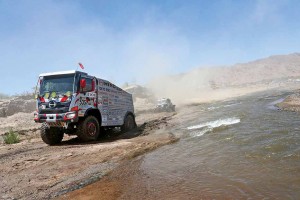
A massive landslide caused by thunderstorms saw Stage 9, from Salta to Chilecito, being cancelled. With the road cut off, the vehicles, competitors, assistance and logistics were diverted to an alternative route through San Antonio de los Cobres, extending the distance by about 200 km. Race caravan regrouped at Chilecito. Eduard Nikolaev brilliantly negotiated Stage 10. The Russian led his two Kamaz team-mates Dmitry Sotnikov and Airat Mardeev. Eduard Nikolaev picked up his second stage victory with a lead of seven minutes over his Kamaz team-mate Dmitry Sotnikov, catapulting him to the top of the general standings for the first time. In Stage 11, the competitors confronted the dunes of San Juan. These stretched for over fifty kms. Leading to the retirement of Gerrit Van Werven, this stage sprang many surprises for truck drivers. Eduard Nikolaev continued to lead. He was the first trucker to get a grip on the day’s special. Nikolaev’s team mates, Dmitry Sotnikov and Airat Mardeev, followed him throughout the course. Nikolaev led Federico Villagra by 41 seconds and Airat Mardeev by one-minute and 18 seconds. Nikolaev won Stage 11 in Rio Cuarto, and was given a tough fight by Argentinean Federico Villagra who wanted to achieve a result on his native land. He fell short by 52 seconds!



